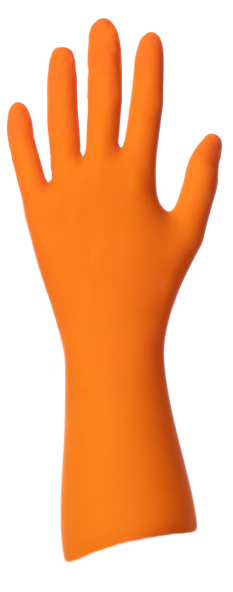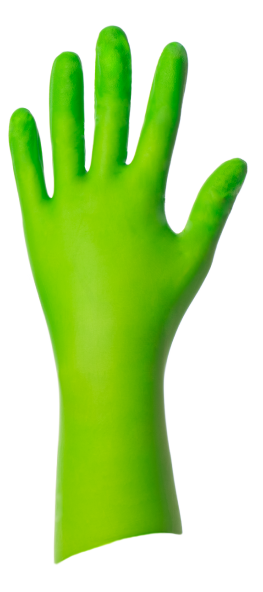Cleanroom Gloves
Cleanroom gloves usage is part of the tough rules in force for activities within Controlled Atmosphere Areas (CAA) where any contamination (particulate, microbiological, chemical) can compromise the processes or the safety of the products and lead to serious health hazards as well as serious economic consequences.
IIt is therefore essential to control the risk of contamination in cleanrooms where the air must be 10,000 to 50,000 times cleaner than normal.
The sterility of a process or the sterility of a finished product can be an additional element requiring working in a sterile cleanroom and therefore wearing sterile cleanroom gloves.
WHAT IS A CLEANROOM?
We call "cleanroom" (according to ISO 14644 and FS 209E) or clean areas a space (a room or a set of rooms) where the control of the concentration of airborne particles, therefore contamination, is essential. We also talk about an ultra-clean environment.
Controlling the concentration of airborne particles requires:
- Managing various parameters (temperature, humidity, relative pressure, etc.)
- Minimizing potential sources of particulate pollution. These sources can be production facilities in the cleanroom (tools, furniture…), external elements introduced into the cleanroom but also movements at the entrance and in the cleanroom (movement of people, flow of goods ...).
For these reasons, filtration and ventilation’s system managing the flow of particles in the air equip the cleanrooms.
Managing the risk of contamination also requires workers to go through several successive gowning areas before accessing cleanrooms to comply with very strict hygiene and cleanliness conditions. Operators usually don garments and PPE (gown, coverall, hood, masks, overshoe, goggles...) specially designed and packed to meet requirements of ultra-clean environments. They may also wear sterile or non-sterile nitrile or Latex cleanroom gloves.
Wearing cleanroom gloves involves both that the gloves meet the cleanliness requirements related to the activity but also that the operators are trained to don and use properly the gloves.
CLEANROOM CLASSES
Cleanrooms are governed by strict regulations mainly based on ISO 14644 which determines several classes fixing the maximum allowable concentration of particles per cubic meter.
The classes ranged from 1 to 9 (1 being the highest level of cleanliness). The table below details the air cleanliness class by concentration of particles:
| ISO classes | Maximum allowable concentrations (particles/m3) for particles equal to and greater than the considered sizes below | |||||
| 0,1 µm | 0,2 µm | 0,3 µm | 0,5 µm | 1 µm | 5 µm | |
| ISO 1 | 10 | n.a* | n.a* | n.a* | n.a* | n.a* |
| ISO 2 | 100 | 24 | 10 | n.a* | n.a* | n.a* |
| ISO 3 | 1 000 | 237 | 102 | 35 | n.a* | n.a* |
| ISO 4 | 10 000 | 2 370 | 1 020 | 352 | 83 | n.a* |
| ISO5 | 100 000 | 23 700 | 10 200 | 3 520 | 832 | n.a* |
| ISO 6 | 1 000 000 | 237 000 | 102 000 | 35 200 | 8 320 | 293 |
| ISO 7 | n.a* | n.a* | n.a* | 352 000 | 83 200 | 2 930 |
| ISO 8 | n.a* | n.a* | n.a* | 3 520 000 | 832 000 | 29 300 |
| ISO 9 | n.a* | n.a* | n.a* | 35 200 000 | 8 320 000 | 293 000 |
*n/a: not applicable
However, the classifications used for cleanrooms may vary by industry:
Annex 1 of the European Guidelines to GMP "Good Manufacturing Practice" particularly concerns the pharmaceutical industry. There are 4 GMP grades: A, B, C or D (A being the highest level of cleanliness). The table below details the maximum permitted airborne particulate concentration:
| Maximum particles/m3 | ||||
| At rest | In operation | |||
| Grades | ≥ 0,5 µm | ≥ 5 µm | ≥ 0,5 µm | ≥ 5 µm |
| A | 3 520 | n.a* | 3 520 | n.a* |
| B | 3 520 | n.a* | 352 000 | 2 900 |
| C | 352 000 | 2 900 | 3 520 000 | 29 000 |
| D | 3 520 000 | 29 000 | Not defined | Not defined |
*n/a: not applicable
There is currently no classification for cleanroom clothing and in particular disposable gloves.
Indeed, the GMP and ISO classifications are based on contamination of particles in the air and only surface contamination levels can be measured on gloves.
It is therefore up to users to decide, according to criteria inherent to their industrial activity, which clean room protection glove will best suit their process.
CLEANROOM GLOVES DESIGNED TO PROTECT
Cleanroom clothing must comply with the industry and the activity carried out. Wearing gloves in a cleanroom must address several goals:
- Protect operators from risks (chemical, microbiological etc.)
- Protect the product
Disposable cleanroom gloves are usually made of nitrile or Latex and are available in sterile or non-sterile versions.
While operating in a sterile environment, it may be necessary to double glove. The double glove ensures that the aseptic environment (class A or B) is maintained by following clothing procedures that require the wearing of ultra-clean sterile gloves before putting on a complete set of sterile clothing, including a second pair of sterile cleanroom gloves. A strict double gloving procedure must then be followed to don properly the 2 pairs of sterile gloves.
CLEANROOM GLOVES CONCERNED ACTIVITIES
Many production and research activities, particularly in the high-tech sector, are concerned with contamination control and therefore cleanroom work.
These can be production, finishing or packaging operations of products that require the wearing of disposable gloves:
- Pharmaceutical manufacturing
- Medicine (pharmacy, preparation of cytotoxic...)
- Biotechnology
- Aerospace and aeronautics engineering
- Automotive industry
- Optics/precision mechanics industry
- Solar industry
- Semiconductor industry, micro-technology, nanotechnologies
- Microelectronics
- Life Sciences
- Food industry
- Cosmetics industry
- Pharmaceutical manufacturing
- Medicine (pharmacy, preparation of cytotoxic...)
- Biotechnology
SHIELD Scientific CLEANROOM GLOVES
SHIELD Scientific has dedicated an entire range, SHIELDSkin XTREME™, to nitrile gloves and Latex gloves for the cleanroom activities.
As contamination control is a key factor, SHIELD Scientific has developed its range of cleanroom gloves according to the level of control sought:
- DI: single washing of gloves in deionised water for basic contamination control.
- DI+ : triple washing of gloves in deionised water for high contamination control.
- DI++ : Multiple glove washes in deionised water for extreme contamination control.
- Sterile: Gamma irradiation to ensure the absence of microorganisms and a low level of endotoxins.
SHIELD Scientific's high-quality cleanroom gloves come in different sizes ranging from 6/XS to 11/XXL for non-sterile gloves and from 5.5 to 10.0 for sterile gloves.
SHIELD Scientific offers 300 mm / 330 mm / 400 mm and 600 mm length gloves to meet on the one hand the needs of protection against human contamination but also the requirements of disinfection of the forearms.
SHIELD Scientific cleanroom gloves meet both product protection concerns and manufacturing procedures as well as regulatory requirements for worker protection (PPE wearing in accordance with current gloves regulations and standards).
All packaging of sterile or non-sterile cleanroom gloves are designed to meet the requirements of processes in ultra-clean environments.
Our glove selection guide will help you select the cleanroom glove that best suits your need. To receive samples or technical documentation, contact a SHIELD Scientific representative or contact one of our specialized cleanroom glove distributors.






